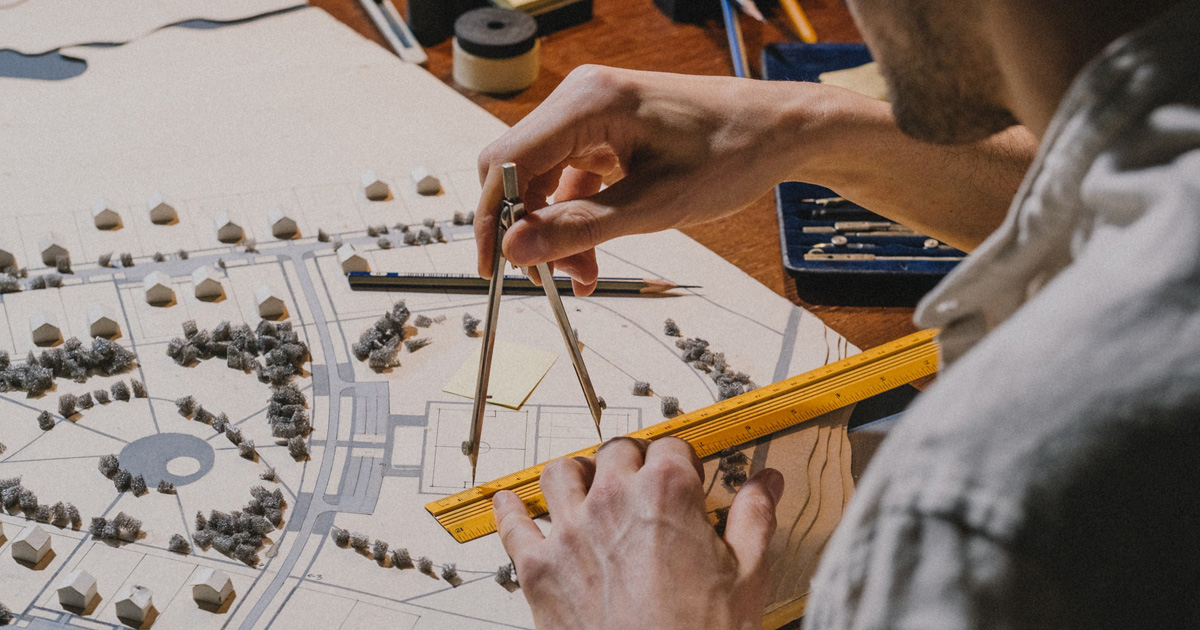Architect Tips for Creating Modern Residential Spaces
Architect Tips for Creating Modern Residential Spaces
Blog Article
Comprehending the Diverse Job Paths Available for Aspiring Architect
As a hopeful Architect, you have a world of occupation paths waiting for you. Each course provides unique challenges and possibilities to use your creative thinking and technological expertise. Whether you're attracted to typical architecture or the subtleties of lasting design, there's a niche that straightens with your rate of interests. Understanding these varied options can shape your professional journey, but which instructions will you pick to check out first?
Traditional Style: Designing Frameworks and buildings
Traditional design focuses on creating buildings and structures that blend performance with aesthetic charm. Your designs can reflect social heritage, showcasing local traditions while meeting modern needs.
You'll create skills in preparing, model-making, and site analysis, allowing you to envision and interact your concepts properly. Involving with customers, you'll need to understand their vision and translate it into viable layouts.
Moreover, developing codes and sustainability practices are necessary in your job, ensuring your structures are safe and eco pleasant. As you grow in your career, you'll locate chances in domestic, industrial, and even restoration tasks, each offering special challenges. Accepting standard architecture leads the way for a fulfilling job that admires the past while forming the future.
Urban Preparation: Forming Areas and Public Spaces
As an ambitious Architect, you can play a crucial function as an urban coordinator, transforming just how neighborhoods function and interact. By utilizing area interaction strategies, you'll assure that residents have a voice fit their environment. And also, incorporating sustainable design concepts will aid create areas that not only meet today's demands but additionally protect the future.
Function of Urban Planners
While many could think of architects as the sole enthusiasts behind buildings, urban coordinators play a vital duty in forming the more comprehensive landscape of communities and public spaces. By teaming up with numerous stakeholders, you'll aid design parks, transport systems, and property areas that promote social communication and accessibility. Your knowledge in spatial style and community dynamics permits you to imagine future development while maintaining social heritage.
Neighborhood Engagement Strategies
Reliable community engagement approaches are crucial for metropolitan planners to assure that the voices of locals are heard and valued in the planning procedure. To foster purposeful discussion, you ought to prioritize open forums and workshops where area members can reveal their ideas and problems. Usage studies and social media sites to reach a more comprehensive audience, ensuring varied viewpoints are included. Teaming up with regional companies can enhance count on and help with much deeper connections. It is very important to offer clear details concerning suggested tasks and decision-making processes, allowing citizens to really feel informed and equipped. By actively including and listening comments, you'll develop rooms that reflect the neighborhood's demands, ultimately causing even more effective and lasting metropolitan settings. Accept openness and continuous dialogue for enduring influence.
Sustainable Design Concepts
When making urban rooms, including lasting layout concepts is critical for creating atmospheres that flourish both ecologically and socially. You ought to start by focusing on power efficiency, making use of products that decrease waste and promote recycling. Take into consideration integrating green spaces, like parks and yards, to improve biodiversity and enhance air quality. Promoting walkability and public transportation can lessen dependence on automobiles, fostering a healthier area.
Creating with water conservation in mind is additionally essential-- think of rainfall gardens and permeable surface areas to manage stormwater. Including area participants during the preparation process warranties that the spaces you create satisfy their needs and motivate social communication. By accepting these concepts, you'll add to vivid, sustainable city landscapes that benefit every person.

Landscape Style: Developing Sustainable Outside Environments
As you explore landscape architecture, you'll uncover crucial layout principles that develop functional and beautiful outside spaces. Lasting methods play an important duty in making sure these environments grow while lessening environmental influence. Plus, you'll locate a variety of career possibilities that allow you to make an actual difference in just how individuals interact with nature.
Style Principles in Landscape
Comprehending layout concepts in landscape design is essential for producing lasting outside settings that harmonize with nature. You'll require to contemplate aspects like proportion, scale, and equilibrium to guarantee your styles feel cohesive and inviting. Including native plants not only boosts biodiversity however additionally reduces water usage, making your landscape resistant. Think regarding the circulation of room and how people communicate with it; paths and seating locations should invite expedition and leisure. Furthermore, take notice of seasonal adjustments, developing with materials that match the environments year-round (Architect). By focusing on sustainability and aesthetic appeals, you can create exterior spaces that enhance the community and promote wellness. Accepting these concepts will establish a strong structure for your job in landscape architecture.
Sustainable Practices Review
Sustainable methods in landscape style not just focus on aesthetics however additionally prioritize environmental health and wellness and source conservation. You can develop areas that advertise dirt wellness, such as utilizing natural products and exercising permaculture concepts. Eventually, these techniques assure your designs benefit both individuals and the environment for years to come.
Job Opportunities Exploration
With a solid structure in sustainable practices, landscape style uses a variety of job courses that enable you to make a meaningful influence on the atmosphere. Urban planners commonly work together with landscape architects to develop eco-friendly spaces in city settings, enhancing city livability. If you're enthusiastic about education and learning, think about becoming a landscape style instructor, motivating future generations.
Sustainable Style: Concentrating On Eco-Friendly Practices
As you discover your career in architecture, welcoming green practices can establish you apart in a competitive field. Lasting layout focuses on developing buildings that lessen environmental effect while enhancing owner wellness. By including renewable materials, energy-efficient systems, and lasting building strategies, you'll add to a greener future.
Begin by obtaining knowledge of eco-friendly certifications like LEED or BREEAM, which can bolster your qualifications. Take into consideration how natural light, air flow, and thermal performance can enhance style. Collaborate with designers and ecological consultants to innovate solutions that lower waste and preserve sources.
Do not fail to remember the value of community involvement-- interesting local stakeholders can influence styles that integrate with the setting. As customers increasingly prioritize sustainability, your expertise in environment-friendly techniques will certainly not just bring in jobs however likewise meet your enthusiasm for accountable design. Accept this crucial aspect of the profession, and more info watch your career flourish.
Historical Conservation: Shielding and Bring Back Cultural Heritage
While you begin on your building journey, think about the crucial role of historic conservation in keeping our cultural heritage. This area concentrates on the defense and remediation of considerable structures, websites, and frameworks that inform the tales of our past. By taking part in historical preservation, you'll help protect the building legacy that shapes community identification.
As a historical conservation Architect, you'll examine historical significance and analyze the condition of structures. You'll function carefully with preservationists and chroniclers to assure genuine repair methods are employed. This career course permits you to mix imagination with research study, allowing you to make remedies that respect initial products and workmanship.
Your job not just adds to sustainability by recycling existing buildings however also promotes a sense of satisfaction within communities. Accepting this path will certainly help you come to be a guardian of history, maintaining the stories and aesthetic appeals that enrich our lives.
Inside Style: Enhancing Indoor Spaces
Historic conservation and indoor style both share a commitment to enhancing the built setting, but they concentrate on different aspects. While historical preservation emphasizes maintaining a structure's historic and social value, interior architecture absolutely nos in on maximizing indoor spaces for functionality and visual appeals.
As an aspiring Architect, you'll find that indoor style enables you to blend imagination with technical skills. You'll design rooms that not only look great yet also advertise comfort and effectiveness. This field involves understanding exactly how light, shade, and products engage within a space, impacting state of mind and use.
You'll function on different projects, from residential get more info homes to commercial workplaces, ensuring that each environment satisfies the requirements of its passengers. By prioritizing individual experience, you can transform insides into inspiring and useful areas, making a considerable influence on exactly how people interact with their environments. Welcome the opportunity to boost interior environments and shape the way people function and live.
Industrial Design: Combining Capability With Looks
Industrial design plays an important function in developing items that perfectly blend visual appeals with capability, making certain that what you use everyday is not only aesthetically attractive yet likewise sensible. As an ambitious Architect, you might immerse yourself in this area, concentrating on creating whatever from furniture to consumer electronics. Your job entails recognizing individual needs, materials, and producing procedures, enabling you to produce innovative options that enhance day-to-day experiences.
In industrial design, you'll often collaborate with makers, online marketers, and designers, ensuring that your styles are not just gorgeous yet also feasible. This job path supplies a dynamic environment where creativity meets functionality, making it a satisfying selection for designers interested in shaping the products of tomorrow.
Often Asked Questions
What Educational Qualifications Do I Required to Come To Be an Architect?
To become a designer, you'll require an expert degree in style, normally a Bachelor's or Master's. Additionally, you'll have to finish a teaching fellowship and pass the Architect Registration Exam to practice legitimately.
Are There Certification Needs for Various Building Job Paths?
Yes, there're qualification demands for numerous building paths. Architect. You'll need to pass examinations, complete teaching fellowships, and occasionally go after specialized training, relying on your picked focus, like landscape architecture, metropolitan design, or historic conservation
What Software Skills Are Vital for Designers Today?

Just How Can I Gain Practical Experience While Researching Style?
You can gain sensible experience by interning at building companies, participating in design competitors, offering for area jobs, or collaborating with schoolmates on real-world jobs. These chances enhance your abilities and construct beneficial links in click here the industry.
What Job Opportunities Exist Outside Traditional Design Firms?
You can explore numerous work possibilities outside conventional architecture firms, like metropolitan planning, indoor design, landscape design, building monitoring, real estate growth, or perhaps duties in sustainability consulting. Each deals special obstacles and rewards.
Whether you're drawn to conventional design or the subtleties of lasting design, there's a specific niche that aligns with your interests.When developing city rooms, incorporating lasting design principles is essential for developing settings that grow both ecologically and socially.As you explore landscape architecture, you'll discover important layout concepts that create beautiful and useful outside areas.Recognizing style principles in landscape architecture is crucial for developing lasting outside atmospheres that balance with nature.In commercial layout, you'll usually team up with marketers, designers, and manufacturers, ensuring that your designs are not only attractive yet likewise viable.
Report this page